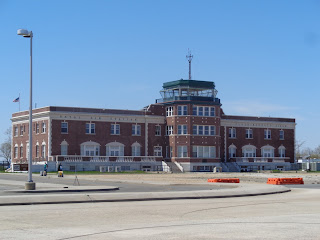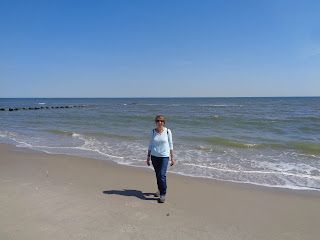from Sheepshead Bay in Brooklyn to Rockaway Beach in Queens.
 |
| Sheepshead Bay with Ocean Avenue Pedestrian Bridge in the distance |
As soon as we hit the water's edge, it was hard to believe we were still in the city. Sheepshead Bay used to connect to Coney Island Creek in the days when Coney Island was still an island, but the construction of the Shore Parkway to link the island to the mainland blocked the waterway so that the western side of the bay is now an inlet. A wide walking path allows for a pleasant stroll alongside the waterside. The inlet is also home to ducks and swans. Unfortunately someone seemed to have taken the idea of feeding them to the extreme. Full size baguettes and whole Kaiser rolls had been tossed into the water despite signs warning not to feed the birds.

Beyond the blue Ocean Avenue Pedestrian Bridge, the bay widens and a series of piers provide a home for fishing boats and charter/tour boats from the basic to the grand. A little further on and our view of the water was blocked by various boat clubs and housing blocks until we reached Plumb Beach, part of the Gateway National Recreational Area.
 |
| Plumb Beach looking out to the Eastern End of Coney Island |
 |
| View from Plumb beach to the Marine Parkway Bridge |
From Plumb Beach we followed the Jamaica Bay Greenway, a mixed use trail, which initially follows alongside the Beltway Parkway. Fortunately, for a good part of the way, trees shield the path from the road and hence the noise of traffic. Our next destination was Floyd Bennett Field, formerly a municipal airport before being converted into a naval air station in 1941. It was named after the first person to fly over the North Pole and its claims to fame include being the departure point for record-breaking flights by Amelia Earhart and Howard Hughes, and being the busiest airport in the United States during World War II.
Our entrance to Floyd Bennett Field was through the narrow chicane gateway shown below. The sign next to it provided much amusement given it stated that bicycles were allowed in the Field - the only apparent way of getting a bicycle in at that point would be to throw it over the fence!
On hearing that the area was classed as a State Park and jokingly compared to Yellowstone, I asked what wildlife we might encounter. No sooner had the eye-rolling suggestions of buffalo and elk been made when we spotted this little fellow:
 |
| It was how big? |
For those who have always wanted to sleep under the stars in New York City, Floyd Bennett Field offers an urban camping program. Other available activities include guided nature tours, kayaking and archery.
Walking on the grassy trail made a welcome change after several miles of hard pavement, but it wasn't long before we were out on the old runway. Not surprisingly, it's a popular spot for model plane enthusiasts and there were several out there that day. I was surprised at how big and realistic the models were. My attempts to take a photo of them in action proved to be woefully inadequate. Or maybe the planes were just moving too fast.

One of the old hangars is home to the Historic Aircraft Restoration Project which, apart from restoring the airplanes, gives visitors a chance to take a close-up look and to even get inside them. The control tower has been turned into an aviation museum. We didn't have time to go into the museum itself, but the picnic tables outside were to be our lunch spot. A large stretch of grass separated us from where we were on the runway and the building, so someone suggested we cut across it rather than take the longer way around. It seemed like a good idea until the first few people stepped onto the grass only to see a large grey snake slither away rapidly in front of them. We quickly decided we weren't that tired after all and opted to stay on the runway!
 |
| Naval Air Station |
From Plumb Beach it didn't look a particularly long bridge, but it turned out to be almost a mile long. It offered wonderful views, including one of a bridge in the distance, the south end of which was apparently where this particular walk would end. We still had a long way to go.
 |
| Jamaica Bay and Rockaway Park - our final destination still seems a long way away! |
 |
| The Verazzano bridge |
 |
| No matter where you are it seems you can see Manhattan |
From the bridge it was a short walk to Jacob Riis Park and finally we were back on the beach. Once again, despite being a beautiful day, there were few people around. All the better, to enjoy the sound of the waves lapping onto the shore - is there a more beautiful sound in nature? Personally, I think not.
The area is known for horseshoe crabs - unfortunately the only ones we saw were dead - though to be honest, I'm not sure I'd want to see a live one up close.
There were other signs of dead sea creatures on the beach. I thought these were fish, but one of our group insisted they were baby sharks!
The whole area was hit badly by Hurricane Sandy in 2012 and while some progress has been made in restoration there still looks a lot to do. The original boardwalk at Rockaway Beach remains fenced off in parts and the damage is plainly visible. The row of strange-looking structures behind the boardwalk are the replacement public restrooms and life-guard station, both of which were destroyed in the storm.
 |
| the old boardwalk at Rockaway Beach |
Other projects include the creation of planted dunes between the beachfront buildings and the sea to help protect against future storms.
We ended our walk at Rockaway Beach, but we had one more treat in store. The only way out of the area for most of us was to take the A subway train which runs across Jamaica Bay and through the Wildlife Refuge. The low tracks with water on both side make it feel as if you are almost in the bay and no matter which side of the train you sit on, there's a great view to be seen, including hundreds of white birds. A scenic subway ride in New York City - who knew?


















No comments:
Post a Comment